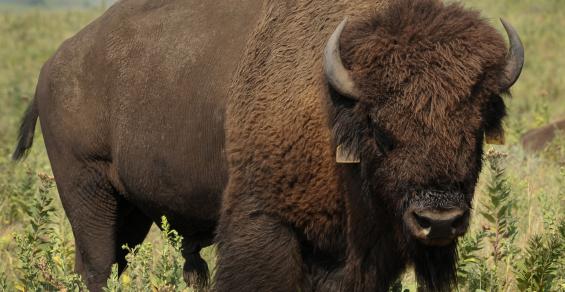K-State researchers find long-term bison grazing has been critical for Flint Hills grasslands.
For many, the Konza Prairie located just south of Manhattan, Kan., has the best nature hiking trails in the Flint Hills, but it also serves as a biological research station — and home to nearly 280 bison.
For more than 30 years, Kansas State University researchers have conducted fire and grazing experiments on the Konza Prairie to study the functions of the ecosystem; specifically, says biology assistant professor Zak Ratajczak, they have been assessing the role bison play in encouraging biodiversity and resiliency in grassland plants.
The removal of bison herds in Kansas began in the 1860s, though a record number of bison in the Manhattan area was recorded in the mid-1880s. They were reintroduced to the Konza Prairie in the 1980s — almost 100 years later.
The reintroduction of bison was significant to tallgrass prairie research, primarily because of grass species like big bluestem becoming dominant without the presence of large-animal grazers.
“What we’ve been finding is that bison are actually very good at consuming this specific species and other dominant grasses in large quantities,” says Ratajczak, lead author of the research article on the long-term bison grazing experiment. “And what that does is it leaves more room and resources for other species to become established.”
Since beginning this project, the quantity of plant species has doubled, which increases the diversity of tallgrass prairie plants.
Drought
Drought conditions experienced in 2012 helped researchers to determine that the resilience of tallgrass plant species has evolved.
“Initially, the number of plant species present decreased by 25%,” Ratajczak says. “But the community was able to recover those losses in two to four years. So, although they weren’t resistant at first, they bounced back afterwards.”
Ratajczak added that events like drought are likely to become more common, more intense and even last longer than the 2012 drought.
“It’s sometimes difficult to actually quantify your local effects of drought, but we do have year-to-year variability, which is a natural part of our weather patterns here in the Great Plains,” says Jesse Nippert, a K-State biology professor and current lead on the Konza research grant. “For native plant communities, you can think not only about mortality and completely dropping out of the system, but sometimes it can be premature senescence [a gradual deterioration of functional characteristics in living organisms], like lack of flowering or loss of local pollinators, in some cases.”
The 2012 drought gave a glimpse into the future of Kansas grassland species’ adaptability when faced with major environmental changes.
Ruminants
Additional research compared cattle-grazing to bison-grazing effects. While they are similar animals — for example, they are both large ruminants, meaning they consume grasses and ferment them through the rumination process — they impact the environment differently.
“What we see so far is that cattle, like bison, decrease the abundance of these dominant grasses, but not quite as much as bison — and that seems to be a part of the reason that they also don’t increase plant species diversity quite as much,” Ratajczak says. “Cattle still have positive effects, but at a slightly different magnitude.”
Different management practices also impact the large-animal grazers’ influence on grassland prairies.
“Cattle graze intensively at higher densities during the summer, and those areas rest during the winter, while bison are present year-round,” he adds.
Research on different management types regarding grassland prairies is expected in the future of this research study.
Funding
This long-term research program is funded by Kansas State University and the National Science Foundation, totaling well over $31.6 million.
“We’re part of what’s called the Long-Term Ecological Research Network, and it has a system of protocols for types of data to be measured the same way, year in and year out,” Nippert says. “We collect data on populations of organisms, changes in soil through time, major changes in nutrient cycling, and also keep climate records.
“By doing the same measurements in the same way, year after year, we notice subtle changes that you wouldn’t notice in a five-year study. And doing studies like this over long periods of time allows us to see patterns and trends that wouldn’t be obvious in a shorter-term experiment,” Nippert adds.
The data measured at the Konza Prairie is available online to anyone locally, nationally and internationally free of charge, according to Nippert.
“These grasslands are our heritage, and they are something to be proud of. And, you know, there’s something to both learn from and respect, and then to continue to investigate — and so I feel very fortunate, and we all do for having this tremendous resource,” Nippert says.
Rohr is a K-State Research and Extension news information intern.



